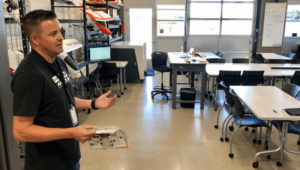Rethinking Assessment to Meet the Demands of the 21st Century Workforce

Don Kilburn
Despite some arguments to the contrary, the value of a bachelor’s degree has never been greater in our country; that’s because the requirements of 21st century workers are rapidly changing and the barriers to entry into the workforce continue to increase.
Recent Labor Department statistics by the Economic Policy Institute show that Americans with four-year college degrees make an astounding 98 percent more per hour on average, compared to those without a degree. In addition, many occupations that previously only required a high school diploma are now demanding a bachelor’s degree. The biggest education challenge standing in front of us, however, is getting more learners to the level that ensures that they will succeed in a degree program.
Put differently, remediation can be a huge impediment to students’ ability to achieve a bachelor’s degree. Fifty percent of community college students and 20 percent of four-year students need to complete remedial core competencies before advancing to a degree program. Additionally, the cost of remedial education –approximately $4 billion every year – is putting an unsustainable burden on state and federal education resources.
It’s time to address the challenges of remedial education to lower remediation costs and allow today’s students to get the skills they need to succeed in education and in their careers.
Putting Students in the Driver’s Seat
Using the Emporium Model of teaching, in which developmental courses are redesigned to combine personalized, mastery-based learning and assessment technology, face-to-face lectures, and open labs with one-on-one assistance, has proven to be successful in boosting learning outcomes.
Otherwise known as “course redesign,” this style of teaching exponentially increases the power of assessment by increasing assessments, giving students a firsthand account of what they understand, and giving instructors the opportunity to intervene before a student falls behind. Assessment should mirror good instruction, happen continuously as part of instruction, and provide educators with information about students’ level of understanding.
Students who advance without full competence in skills are doomed to struggle, if not fail. By reaching students at the exact moment they are trying to understand and requiring full comprehension before they move on, we can help prevent students from falling through the cracks later on in their education.
One State’s Innovative Approach to Remediate High School Math Students
Tennessee is a flagship state for how successful this model can be for students. Prior to the Emporium Model, nearly 70 percent of students entering community colleges across the State required at least one semester of developmental math classes. Many students were unprepared for college-level math and were subsequently dropping out. The Tennessee Higher Education Commission, in partnership with the Tennessee Board of Regents and the Tennessee Department of Education, looked to the Emporium Model to raise college completion levels.
At Chattanooga State Community College after the success of the institution’s original pilot program using the Emporium Model of teaching, the program was expanded to include 200 high school students. After the first year, 83 percent of students who graduated high school were college ready in math. Approximately 25 percent of those students completed bridge math classes early and were able to complete a college level math course during their final semester in high school, enabling them to enter college one semester ahead in math. At Cleveland State Community College, after the first year of using the Emporium Model, 70 percent of students completed their bridge math courses and graduated college ready in math. Thirty percent completed not only the bridge math course, but also completed a college course taken as an elective in high school.
Staying on the Track to College
To accelerate their completion of remedial courses and stay on track to complete a certificate or degree program, students should take advantage of personalized learning technology that provides assistance outside of classroom time, such as online self-paced learning and assessment tools. These resources help students test their knowledge to determine areas of strength and struggle. Then, students can work at their own pace to master difficult concepts, and monitor their progress along the way.
Assessing Outcomes at Every Stage
Pearson’s Impacts of the Digital Ocean on Education report details the unprecedented opportunity that today’s educators have to use technology to understand learner activities in testing and non-testing environments. Given that 85 percent of teachers in the United States already use technology in their classrooms each day, according to the report, personalized learning at scale is becoming a reality, as this digital world of teaching and learning collides.
The report identifies six areas of impact that continuous assessment of outcomes is having and will continue to have on teaching and learning.
- Interaction. Computers will score a wider range of responses from students, allowing teachers to provide more meaningful assessments of student learning and personalize instruction accordingly.
- Data. Evidence-based interactions between learners and the learning material will help educators understand learners’ processes when solving problems.
- Pattern Seeking. Analysis of anonymous data will enable teachers and researchers to uncover new patterns that may provide evidence about learning behavior.
- Immediate Feedback. Rapid interpretation of data will enable teachers to provide immediate feedback to learners, and help administrators provide targeted feedback to teachers.
- Learner Profiles. Connecting information enables educators to build a more intelligent and complete understanding of learners.
- Activity Recommendation. With a wide range of data and a better understanding of processes, educators will be able to determine the best subsequent activity for the learner’s effort to meet a particular goal (e.g., motivation).
The end result of all of this effort is a better understanding of a learner’s knowledge and skills, which can help the learner with taking the next step.
Next Steps for GenDIY Teachers
With new options and access powered by technology, Generation Do-It-Yourself students are exploring new learning opportunities that’s changing the roles of educator. Teachers will undoubtedly benefit from investing time and energy into becoming well versed in effective educational technology tools that create learning experiences that are personalized, and continuously adaptive. Understanding how students are actually performing and offering data-driven guidance will help learners better absorb course material and understand challenging concepts.
Tools that provide teachers with actionable data enable educators to monitor each student’s progress in a course, evaluate the achievement of learning outcomes, and intervene when needed to keep learners on track to completion.
To view a series of videos featuring community college educators on their use of technology to improve learner outcomes, visit pearsoned.com.
For more on Pearson, check out:

Don Kilburn is President of Pearson North America. Follow Don on Twitter, @donaldkilburn.




0 Comments
Leave a Comment
Your email address will not be published. All fields are required.